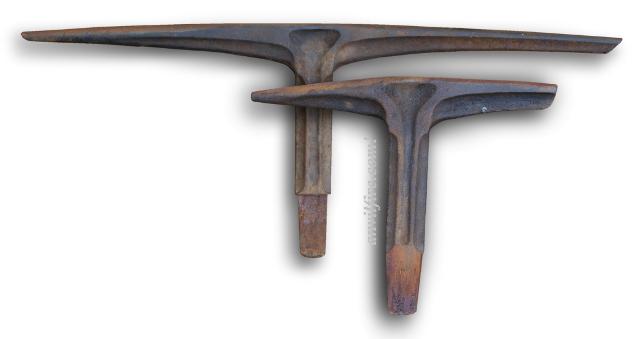|
|
| |
| |
|
|
|
|
|
|
|
|
| |
| |
| |
| |
| |
| |
| |
| |
| |
| |
|




| |
| |
|
Tell them you found it on anvilfire.com!
|
Anvils,
Amboß Amboss,
l'enclume,
incudine,
el yunque, bigornia,
städ,
incus,
aambeeld,
batente,
наковальня
Stake, sheet metal, forming.
|
|

Photos provided by Andy Mason, UK, digitally processed and grouped by Jock Dempsey.
Several things make these stakes unique.
The first is their graceful curve that hints of use in streamlined aircraft or automobile manufacturing.
The cloeset shape to these in my catalogs are what is called an "extinguisher stake" but they are generally very straight and no longer than the shorter of the two stakes above.
The second unique feature is the ribbed cross section of the stake.
The post is # shaped and the working surfaces T shaped in section.
The third unique feature is the rectangular wedge shaped taper rather than the standard square.
The tools have both art and engineering making the tool more expensive to manufacturer than most.
I suspect these are cast steel to obtain the shape and strength needed.
The flaring depression extending from the side groove to the head of the stake is careful pattern making trying to prevent large masses where shrinks would occur in a steel casting.
All these features combine to say that this was a manufacturer of high quality tools at one time.
It would be nice to know who the manufacturer was.
Like many old tools the age and origins are often hard to determine. These are most likely early to mid 20th century.
These could be of Continental origin as easily as English.
Dimensions:
Large: 30" long, 11" tall, 2" wide (~762 x 280 x 50 mm)
Small: 14" long, 11" tall, 2" wide (~356 x 280 x 50 mm)
|
Links:

Return to Andy Mason Antique Tool Collection
Stakes, anvils and more.

Stakes and Stake Anvils page
Stake Names (American English)

|
|






städ, incus, aambeeld, batente, наковальня Stake, sheet metal, forming.